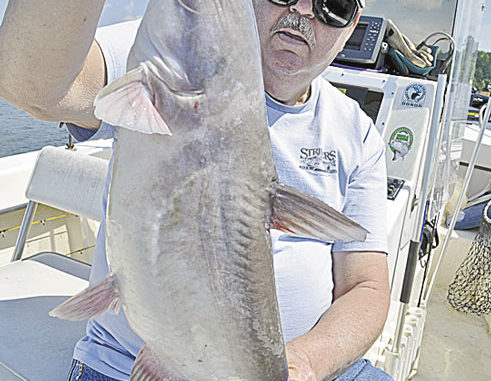
You’re liable to catch a lot more Kerr Lake catfish if you learn to ‘use your noodle’
Marion F. “Ramrod” Hall figures Tony Milam and Michael “Chubb” Reaves may owe him one.
Hall was catfishing with a friend at John H. Kerr Reservoir in May 2010 when he lost an estimated 100-pound-plus blue catfish at the gunwale of his boat. This past March 17, Milam and Reaves landed a 109-pounder near the same spot, a fish that became the Virginia state-record blue cat.
“When I heard about their 109-pounder, I told Dickie (Smith), ‘They done caught our fish,’” said Hall, who has been fishing at Kerr Lake, aka Buggs Island, for almost 40 years – the last 21 as a guide – and has landed hundreds of big catfish from the 49,500-acre impoundment straddling the North Carolina-Virginia border.
However, Hall doesn’t use a rod and reel for catfishing, as Milam and Reaves did when they pulled their prize-winner from the lake close to where the Dan and Staunton rivers merge.
Hall fishes with “noodles,” which most people associate with catching small catfish, but he said nothing could be farther from the truth. Noodle fishing is just as effective as catching monster catfish with hook and line — and it’s more effective.
“Me and ‘Double Ought’ Smith) were fishing noodles near where the Dan and Staunton rivers split, probably in the same area they caught their 109-pounder,” Hall said. “One of our noodles started bouncing, then it went down, then it came up and started moving across the lake. We chased it down, caught up to it and got it aboard, and both of us started pulling on the line. We couldn’t believe the weight of the catfish that was at the other end.
“When we got the dadgum thing to the top, we couldn’t lift it in the boat. It looked longer than either one of us.”
They managed to get a gaff in its throat, but because of the fish’s size and strength, the tool didn’t provide enough hoisting power.
“(The fish) rolled and ripped the gaff out of its throat,” Hall said. “All we could do was watch him slide away.”
Hall, who has caught thousands of Kerr Lake catfish, believes if this huge blue cat wasn’t the same fish that Milam and Reaves landed, it was one that was pretty close.
“It could have been another catfish,” he said. “But that just proves Buggs Island Lake has more than one monster catfish, and you can catch them with noodles.”
“Noodling” is a term used interchangeably with “grabbling” in other parts of the country. Grabbling is a technique where people, often wearing scuba gear or diving masks, go underwater and reach under streambanks or logs and grab catfish and pull them to the surface. But noodling has an entirely different meaning at Buggs Island.
Hall said he started “noodling” about 18 months ago when a fisherman from Liberty, Steve “Termite” Fogleman, started making and selling catfish noodles he created. Hall, who has known Fogleman for years, bought a couple dozen from him.
A noodle is nothing more than a piece of tubular foam — a swimming-pool floatation aid for children — cut into 12- to 14-inch sections and fitted over an 18-inch section of half-inch PVC pipe that anglers tie line, weights, hook and baits to and allow them to float across a lake, moving those baits in the strike zones of catfish. Once a catfish bites, the noodle stands vertically in the water, indicating a fish has struck. Anglers simple motor to the noodle and haul the line and the catfish to the boat.
“I think a lot of other people stopped fishing for stripers because the lake doesn’t have any large ones any more, so they turned to catfishing,” Hall said. “I used to guide a lot for stripers, but since they got gill maggots (lice) in them that came down the (Staunton) river from Smith Mountain Lake, the big stripers have died out. You just don’t have sizes of stripers in the lake like you once did, but there are a slew of small ones.
“People have been catching some huge blues and flatheads, and the chance to catch a trophy fish has brought out a lot of people.
“And you sure can catch them with noodles.”
The major advantage of noodle fishing is anglers can cover more territory and put out more baited hooks than they can fishing from a boat.
Although Hall and other noodlers use 2-ounce barrel weights to get their baits deep in the water column, noodles and the baits are moved by current and wind and can float across fairly large distances. The challenge is keeping up with them.
When a noodle is vertical, bobbing or moving and bobbing, it means a fish has taken the bait. Hall sometimes uses a plastic zip-tie to attach a second foam piece to the basic one-piece noodle to keep large catfish from pulling the floats underwater.
Hall usually puts out from 15 to 24 noodles and uses his trolling motor to move from noodle to noodle when a fish hits. Designed to stand vertically on the surface, the brightly-colored noodles can be seen for hundreds of yards.
“You know you’ve got a big one on when he takes a noodle under, and he stays down with it for four or five minutes,” Fogleman said. “It’s going to be a 20-pounder at least.”
Hall has put blue cats weighing 50, 48 and 40 pounds in his boat while noodle fishing.
“I use leather gloves to pull in my line when I’ve got a big cat on so (the line) won’t cut my hand,” he said.
Hall is particular about the fish he cuts up to use for bait.
“I use white catfish belly chunks cut into about 1-inch squares,” Hall said. “They’re the only baits I use. Other people use bream or crappie fillets, but you have to keep the head and tail of a filleted panfish in your boat if you’re checked by a game warden to make sure you haven’t used too small a fish (crappie must be at least eight inches long, and anglers are only allowed 20 crappie per day at Kerr).
“If you use catfish chunks, you don’t have to worry about catching bait or keeping panfish bodies. I also believe they’re the best catfish baits on the lake.”
Hall, who, uses freezer bags to hold his bait chunks and keeps them in his freezer until he’s ready to fish, said the entire lake contains catfish, but certain spots are better than others. He likes to fish near Clarksville, Va., on the west side of the lake at several flats near the two US 58 bridges and the railroad trestle that cross the lake. Blues, flatheads, channels, bulls and white catfish live in the lake.
“There’s a belief that catfish are bottom feeders, but that’s not so for most species,” he said. “You might catch channel cats on the bottom and bullheads, but blues and flatheads are always cruising, looking for something to eat,” Hall said.
The flats east of Clarksville are relatively deep, as much as 30 feet, but those are perfect places for noodling. Hall puts out noodles with lines ranging from 10- to 28-feet in length.
“I’ve caught blues using chunk baits on noodles with baits varying from 10- to 28-feet deep,” Hall said. “Blue cats don’t feed on the bottom.”
Hall landed a 75-pound blue cat last May while fishing with noodles, a fish that earned him a citation from the state of Virginia for the biggest fish caught from the lake that month.
“I caught a 62-pounder near Buoy 16, too,” he said, referring to a buoy that’s two miles east of the new US 58 span.
“There’s an underwater island where the river channel splits near Buoy 16 that’s a really good place,” he said. “It’s got flooded timber on that island in 40-some feet of water, and you usually can see catfish on your depthfinder around those trees.”
Catfish are plentiful in areas of the lake other than Clarksville, such as Nutbush Creek, Hall said.
A light wind makes for a perfect day, a condition that often occurs during July.
“You put your noodles out on the upwind side of one of those flats, which are near the river channel,” he said. “Most strikes seem to occur near the drop-off (of the channel), but they can happen anywhere.
“When the wind’s knocking too hard, though, you might as well stay home because it blows the noodles too fast.”
Retired from Phillip Morris Tobacco in Richmond, Va., Hall, 71, has many favorite catfish spots marked on his GPS unit.
“I’ll fish about 30 to 40 minutes at a spot, and if nothing’s happening, I’ll pick up my noodles and move to another place,” he said.
When the temperature climbs near 100 degrees in July, some anglers fish for catfish at night to escape the heat.
“Some will beach their boat on a sand bar, build a campfire and put out six or eight rods and fish all night,” he said.
“I just like to put my canopy up for some shade when the sun’s beating down, put out my baits and relax with a cold drink. I think that’s using my noodle the smart way.”

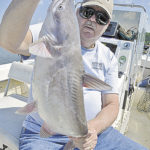
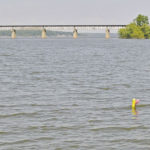
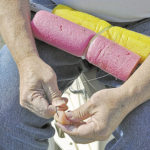
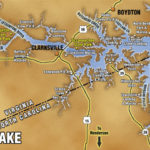




Be the first to comment